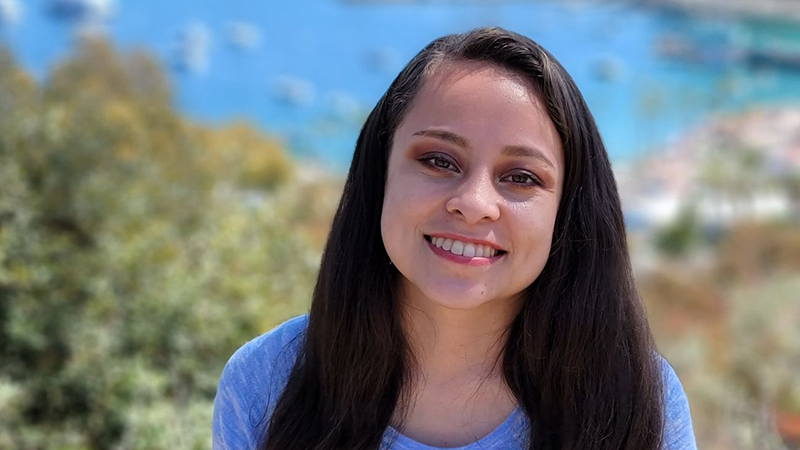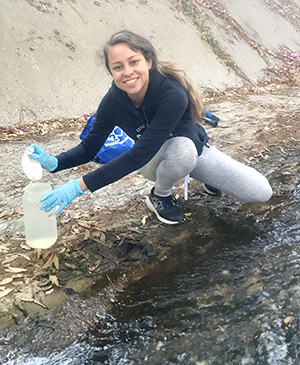First-Gen Latinx Engineering Ph.D. Student Leads Research on Water Quality in Belize

Credit: Bryan Galdamez
Ileana Callejas
Callejas is currently pursuing her Ph.D. in environmental engineering at the UCLA Samueli School of Engineering. The soon-to-be triple Bruin used remote sensing technology to quantify how water clarity in Belize had improved without the usual influx of tourists drawn to this popular Caribbean destination known for its rich coral reefs and marine life.
“Ironically, the pandemic provided a rare opportunity to study the environment without the effects of human travel,” said Callejas, whose advisor is Jennifer Jay, a professor and vice chair of graduate education in the Civil and Environmental Engineering Department. “Belize’s coral reefs bring lots of tourism to the country, but their citizens also have to consider how much travel and development affect the clear water that corals need to survive. Without tourists coming after Belize’s shutdown, there was an opportunity to study how less boat activity affects the clarity of their coastal waters.”
The Belize Barrier Reef is the largest coral reef system in the Northern Hemisphere and second largest in the world after the Great Barrier Reef in Australia. Since 1996, the Belize Barrier Reef has been designated as a World Heritage Site by the United Nations Educational, Scientific and Cultural Organization (UNESCO). To preserve the country’s coastal waters, which are essential to the survival of corals, Callejas said it is important to monitor water clarity to understand how development, land changes and other human activities affect coastal resources.
“Ironically, the pandemic provided a rare opportunity to study the environment without the effects of human travel,” Callejas said.
“The corals need clear water to flourish because light needs to penetrate the corals at the bottom of the water column,” Callejas said. With increased tourism comes boat activity accompanied by garbage in the water. While turbid waters may not pose a direct threat to human health, the particles can provide food and act as a vector for pathogens. These human activities can lead to “nutrient loading” — a condition that causes a surplus of nutrients such as nitrogen and phosphorus, spurring algal growth that not only lowers water clarity but can also deplete its oxygen levels, which can lead to fish kills.
Callejas conducted the research as an intern at the NASA Jet Propulsion Laboratory (JPL), where she has worked since August 2020. Advised by a fellow Bruin environmental engineer and now NASA scientist Christine Lee ’05, M.S. ’06, Ph.D. ’10, Callejas and her teammates relied on images from NASA’s Aqua satellite and its operational algorithm to calculate water clarity. She accessed the satellite imagery via Google Earth Engine, implementing the algorithm and exporting maps and time-series data. The team quantified and mapped the 2020 monthly averages of water clarity and compared them to numbers in previous years. Callejas worked with collaborators in the U.K. and Belize, as well as researchers at NASA, University of Georgia and University of Alabama. According to their research, the areas that normally have high levels of marine traffic had significantly improved water clarity during Belize’s shutdown while areas with typically low levels of marine traffic had similar water clarity before and during the shutdown.

Credit: Jennifer Jay
As a first-generation Latina and the first one in her family to have a college education, Callejas has come a long way from a childhood of an immigrant family. Born and raised in Los Angeles, Callejas’ parents immigrated to the U.S. from Mexico and El Salvador. They didn’t go to college and didn’t understand enough English to help Callejas and her two younger siblings with their homework. Callejas recalled the time when she had to get help from neighbors, classmates and even YouTube tutorials when she had difficulty understanding schoolwork. Nevertheless, she said it was her father’s hard work running a small handyman business and his insistence that his daughter pursue an academic career that made her who she is today — a doctoral student, a researcher and an engineer with a strong work ethic and sense of purpose.
Callejas chose to study at UCLA not only because of its stellar program but also because it is close to home and the in-state tuition meant less of a financial burden on her parents. Originally a biochemistry major, Callejas was drawn to environmental studies after taking a Fiat Lux class in environmental science. The interdisciplinary nature of the field and a chance to learn about the impacts of the environment on people sparked her interest, so she changed her major to environmental science with a minor in environmental engineering.
“At the time, California was going through a major drought. There was news of water contamination in Flint, Michigan, and protests surrounding the Dakota Access Pipeline, which posed a threat to the water supply of Indigenous people,” Callejas said. “I really wanted to learn more about solutions to issues surrounding water quality and supply.”
Since joining UCLA, Callejas has received the National Science Foundation Traineeship, Charles F. Scott Fellowship, Eugene V. Cota-Robles Fellowship, Graduate Degrees for Minorities in Engineering and Science Fellowship and is a Center for Diverse Leadership in Science Early Career Fellow, Hispanic Scholarship Fund Scholar and Graduate Opportunity Fellowship Program Fellow.
Callejas hopes to continue putting her engineering skills to use in a way that teaches and serves others, as her research on Belize did. In addition to using remote sensing to monitor water-clarity trends, she also would like to look at development and land-use changes in Belize, as well as turning her focus closer to home and studying antibiotic resistance in surface waters in Los Angeles.
Sara Hubbard contributed to this story.
